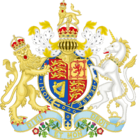Currency and Bank Notes Act 1928 facts for kids
| Act of Parliament | |

|
|
| Long title | An Act to amend the law relating to the issue of bank notes by the Bank of England and by banks in Scotland and Northern Ireland, and to provide for the transfer to the Bank of England of the currency notes issue and of the assets appropriated for the redemption thereof, and to make certain provisions with respect to gold reserves and otherwise in connection with the matters aforesaid and to prevent the defacement of bank notes. |
|---|---|
| Dates | |
| Royal assent | 2 July 1928 |
| Other legislation | |
| Amended by |
|
|
Status: Partially repealed
|
|
| Text of statute as originally enacted | |
| Text of the Currency and Bank Notes Act 1928 as in force today (including any amendments) within the United Kingdom, from legislation.gov.uk | |
The Currency and Bank Notes Act 1928 was an important Act (a law made by the UK Parliament) that changed how banknotes were handled in the United Kingdom. This law helped to make the country's money system more stable.
One of the key things this Act did was to make it against the rules to damage or draw on banknotes. This helps keep our money looking good and working properly for everyone.
Contents
What was this Act about?
This law, passed in 1928, was all about how money, especially paper money (banknotes), was managed in the UK. It brought big changes to who was in charge of printing and controlling banknotes.
Before this Act, different banks could issue their own notes. This law aimed to make things simpler and safer for everyone.
Why was this Act needed?
After World War I, the way money worked in the UK changed a lot. The government had been issuing special "currency notes" during the war. These were different from the banknotes issued by the Bank of England.
The government wanted to go back to a more traditional money system. They also wanted to make sure that the country's money was backed by enough gold.
What did it change?
The Currency and Bank Notes Act 1928 made the Bank of England the main issuer of banknotes in England and Wales. It also affected how banks in Scotland and Northern Ireland issued their notes.
This meant that most of the paper money you used would come from one central place, making the system more organized.
Banknotes and Gold
A big part of this Act was about "gold reserves." This means the amount of gold a country holds to back its money. The Act made sure that the Bank of England had enough gold to support the value of the banknotes it issued.
This helped to build trust in the British currency. It meant that the paper money had real value behind it.
Keeping Banknotes Safe
The Act also included a rule about defacing banknotes. To "deface" means to draw on, tear, or otherwise damage money. The law made it clear that doing this was not allowed.
This rule helps keep our banknotes clean and usable for everyone. It ensures that money can circulate easily without being damaged.
Important Dates
- 1928: The Currency and Bank Notes Act was passed by the UK Parliament.
- 2 July 1928: The Act received Royal Assent, meaning it officially became a law.
Over the years, parts of this Act have been updated or replaced by newer laws. However, its core ideas about managing banknotes were very important for the UK's financial system.

